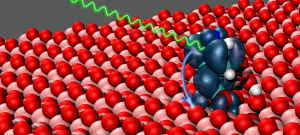PhD Thesis Defense- Moritz Müller
 Theory of Ultrafast Charge Transfer from Localized Quantum
Theory of Ultrafast Charge Transfer from Localized Quantum
States at Surfaces
Candidate: Moritz Müller
Supervisor: Daniel Sánchez Portal
Research group: Modelization and Simulation
When: April 5 (11:00h)
Where: CFM Auditorium
Summary

Dye-molecule (isonicotinic acid) adsorbed on rutile titanium dioxide: excitation by incoming light radiation and subsequent charge injection into the substrate.
The ability of materials to transfer electrons is a basic property controlling the functionality and performance of devices at the nanoscale. Of particular importance is the transfer of electrons at surfaces as a fundamental process in catalytic and photocatalytic applications. This work aims along these lines at a theoretical description of resonant charge injection at surfaces using a combination of density functional theory and Green’s functions.
A close comparison with available data from core-hole-clock experiments is maintained throughout the work and confirms the validity and predictive power of our first-principles approach. This is demonstrated on the basis of three prototypical systems where we study fundamental aspects of charge transfer providing additional, often complementary information to the interpretation of the experiments.
First, we gauge the effect of structural fluctuations at finite temperatures on the charge transfer dynamics at rutile TiO2(110) surfaces sensitized by isonicotinic acid molecules in relation to photovoltaic applications. We find that, the inclusion of such fluctuations reconciles the theoretically extracted charge transfer times with the results from core-hole-clock experiments at room temperature. We study in detail how variations in the geometry and the presence of a core hole affect the interfacial level alignment and discuss how the available amount of acceptor states shapes the temperature broadened resonance spectra in our simulations.

Temperature broadened molecular resonances of core-excited isonicotinic acid on rutile titanium dioxide in front of the density of states of the substrate.
Second, we explore spin-dependent charge transfer on ferromagnetic substrates for the example of argon on Co(0001) and Fe(110). Here, recent core-hole-clock experiments reported a strongly spin-dependent charge transfer behavior regarding the injection from core-excited argon atoms. Our calculations reproduce the experimental observation of significantly faster decay of core-excited Ar*4s minority resonances in comparison with majority excitations, allowing for a detailed analysis of this phenomenon. We find, in particular, that the position of the Ar*4s resonance with respect to projected gaps around the Γ-point of the surface band structure is crucial to explain the spin-dependent behavior, with important implications for spintronic applications.
Third, we closely examine the directionality of charge transfer in relation to sulfur derived resonances at surfaces of the layered transitionmetal dichalcogenide 1T-TaS2. In this joint experimental and theoretical work we analyze the origin of a change from anisotropic to isotropic charge transfer behavior across the phase transition from the nearly commensurate to the commensurate charge density wave phase at low temperatures. Our calculations reveal that the isotropic behavior of the ultrafast electron transfer in the commensurate charge density wave phase is presumably rooted in an increase in interlayer coupling and not the result of a reordering of the charge density wave stacking in subsequent layers of the material.




 Theory of Ultrafast Charge Transfer from Localized Quantum
Theory of Ultrafast Charge Transfer from Localized Quantum